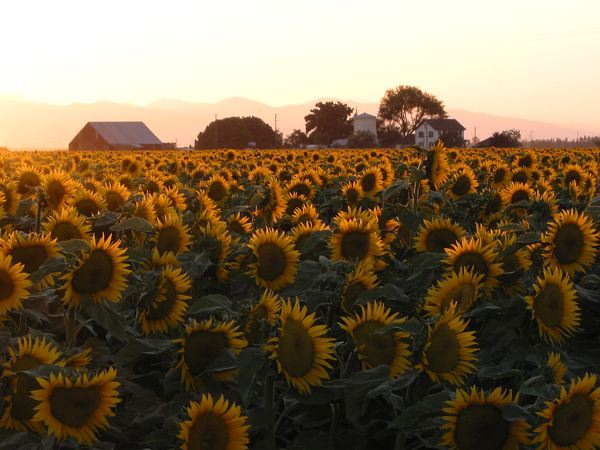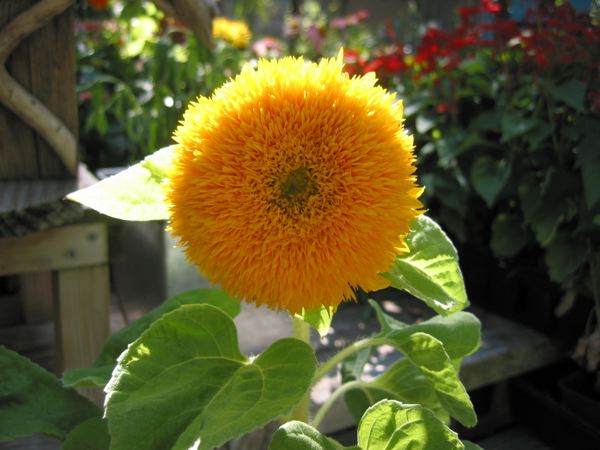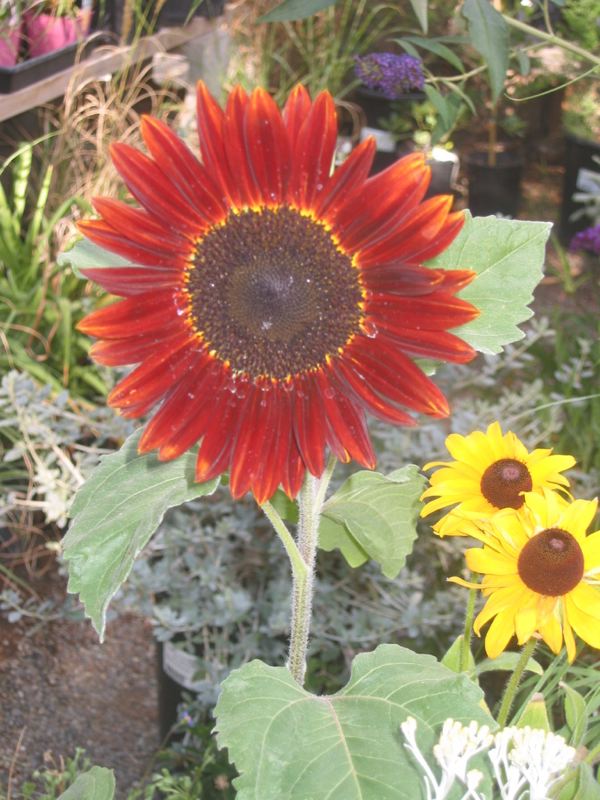Sunday, May 6, 2012
Friday, May 4, 2012
You Can Grow That! May 2012: Sunflowers!
Sunflowers!
"Good mornin'.
You sure do make it like a sunny day.
Sunflower
fair warnin'.
I'm gonna love you if you come my way." --Glen Campbell, 1977
I listened to that song repeatedly as I drove across the western states in the summer of 1977. It was Glen Campbell's last top-10 hit, and it dominated the country-western airwaves that year. Between California and South Dakota in the summer of 1977, the ONLY airwaves were country-western. To this day, I frequently burst into song at the sight of a field of sunflowers, much to the chagrin of my kids.
Fields of sunflowers have become a lovely and common sight in Yolo and Solano counties in recent years. Sunflower acreage increased 44% between 2003 and 2004, to over 13,000 acres, with farmers growing them for production of certified seed. Many of the fields that used to be in processing tomatoes now give us glorious blooms in July and early August.
From an aesthetic standpoint, this is a big improvement! The fields are a photographer's delight. Sunflowers also draw beneficial insects and are pollinated by many species of native bees. At least 29 species of native bees have been found visiting sunflowers in fields in Yolo County, especially species of long-horned and sunflower bees, followed by bumble bees and sweat bees. Most of these are ground-nesting solitary species.
In fact, the native bee species are more effective sunflower pollinators than honey bees, and they even make the European honey bees more effective. Why? European honey bees tend to specialize in nectar or pollen, and the two types of sunflowers planted in commercial fields – being male or female varieties -- have mostly one or the other. So the honey bees mostly stick to one type of flower. But the native bees bully the Europeans, chasing them between the rows, and making them up to 10 times more productive! Typical aggressive Americans.
Helianthus annuus is a western North American native. Western Native Americans domesticated it, with archeological evidence of cultivation as early as 2300 B.C. So it would even predate the Three Sisters (corn, beans, and squash). Sunflowers were used for food, dye, face-paint, oil, hair treatment, and even wart removal, snakebite and sunstroke treatment.
The plant was introduced to Europe and became very popular in Russia, where sunflowers were bred for their oil content (28 – 50% oil). Sunflower oil has been researched as an alternate fuel source, having 93% of the energy of US #2 diesel fuel. Russian varieties were re-introduced back into Canada and the US for vegetable oil production.
There are many varieties for oil, seed, and flowers: an agricultural research station at Iowa State has a repository of over 2,000 varieties. In the last twenty years three new types of sunflower varieties have been introduced. Dwarf varieties include Sunspot and Teddy Bear, each 12 – 18' tall. These are great for containers, and fun for kids to grow.
Cutting varieties branch, producing multiple (but smaller) flowers, and come in colors including red, mahogany, pale yellow, and white. Good examples are Italian White, Indian Blanket, and Parasol Mix. Some are pollenless, a real advantage for cutting since sunflower pollen stains fingers, fabric, and surfaces. Good pollenless varieties include Prado Red (rich garnet color) and Velvet Queen (a 'combination of bronze, burgundy, chestnut red, and mahogany' – Sunset Western Garden Book).
The sun 'flower' is actually a composite structure made up of 1,000 – 4,000 little tiny flowers (florets), compressed onto a flattened stem. Typically there are showy ones along the edge, which are male or 'ray' flowers, surrounding female or 'disk' flowers in the center of the head. Each disk flower has a little nectar to draw the bees; hummingbirds are also very attracted to them.
Why does the sunflower face the sun? The reaction is called phototropism (light+movement). An internal hormone called Indole acetic acid regulates this process. IAA is the hormone in plants which stimulates cell growth and enlargement wherever it is located in the plant. It is very light-shy and very mobile within plants. At night it is all throughout the plant. In the morning it migrates to the shaded west side of the plant, causing the stem to stretch gradually to the east, and in the afternoon this reverses. This continues until the stems become woody.
Sunflowers are incredibly easy to grow in all climate zones! Plant in full sun. They germinate fastest in warm, loose soil. But seedlings can actually tolerate some frost, so in the Sacramento Valley seeds can be started as early as February and planted out in March. Or they can be sown directly in the ground as late as August.
For the tallest plants and biggest flowers, plant in April or May into soil you've enriched with compost and fertilizer, and water frequently. The standard variety for competitive size and maximum production of quality seeds is Russian Mammoth, a variety that's been around for over 140 years. But sunflowers can be planted into mid-summer for pretty flowers, for cutting, and for seed production, and don't require special soil or care. You can just leave the plants to make seed and topple over, and songbirds will thank you.
There are a couple of sunflower relatives worth mentioning, both very easy to grow in full sun and pretty much any soil. Helianthus multiflorus is a hardy perennial that can be grown in every climate zone in North America, with many-branched stems topped with 3-inch sunflowers. There is a double-flowered form. H. tuberosus is the Jerusalem artichoke. This common name mystifies me. It isn't from Jerusalem: it is native to eastern and central North America. And the part you eat doesn't look or taste anything like an artichoke. It is a starchy tuber with a texture like a potato and a slightly nutty flavor. The plant grows to 6'+, with bright yellow single sunflowers, and spreads – shall we say? – freely.
good mornin'.
You sure do make it like a sunny time.
Sun mornin'
good mornin'.
And some da child
I'm gonna make you mine. (repeat'and repeat'.and repeat'.)
Subscribe to:
Comments (Atom)






